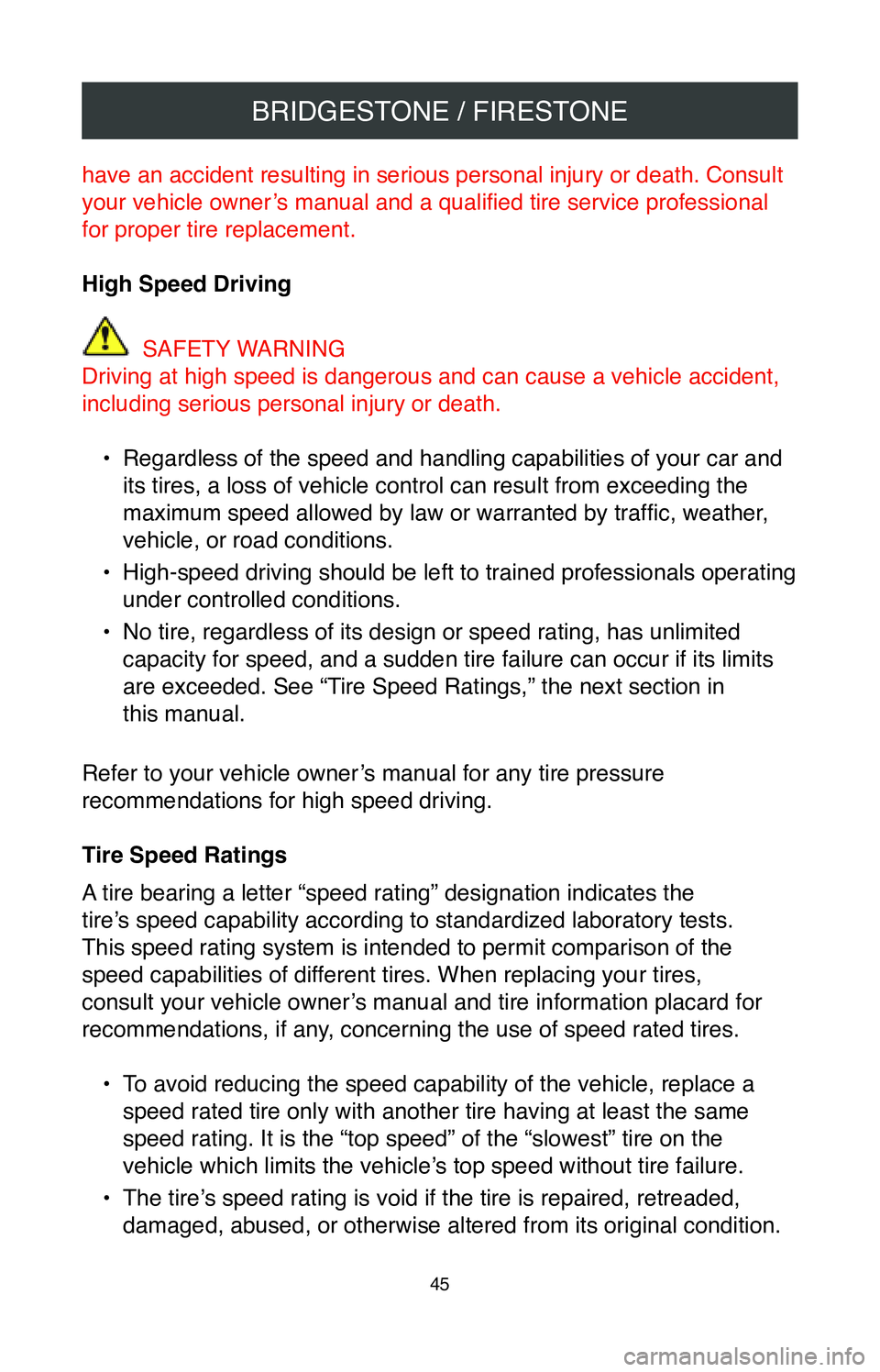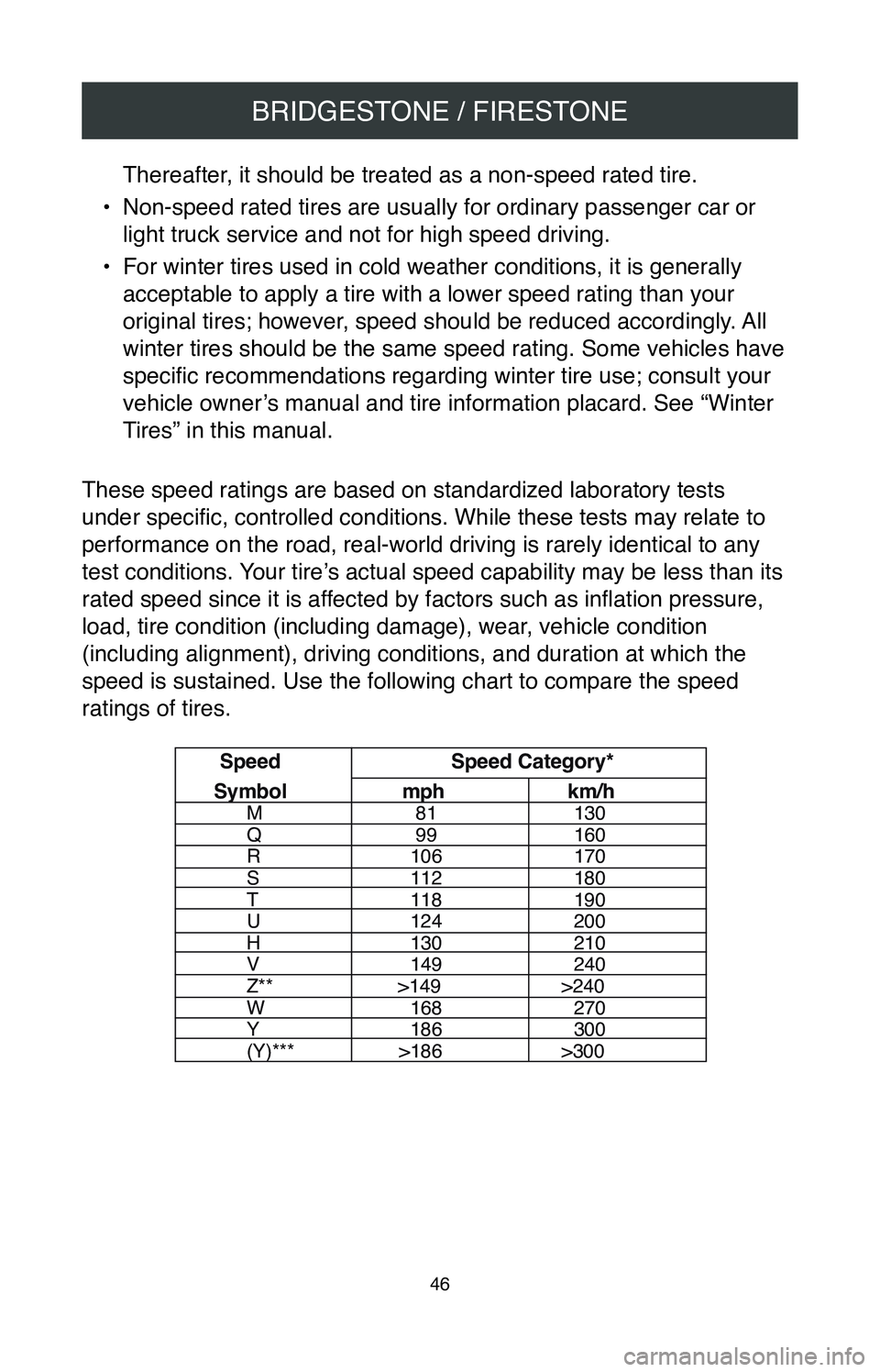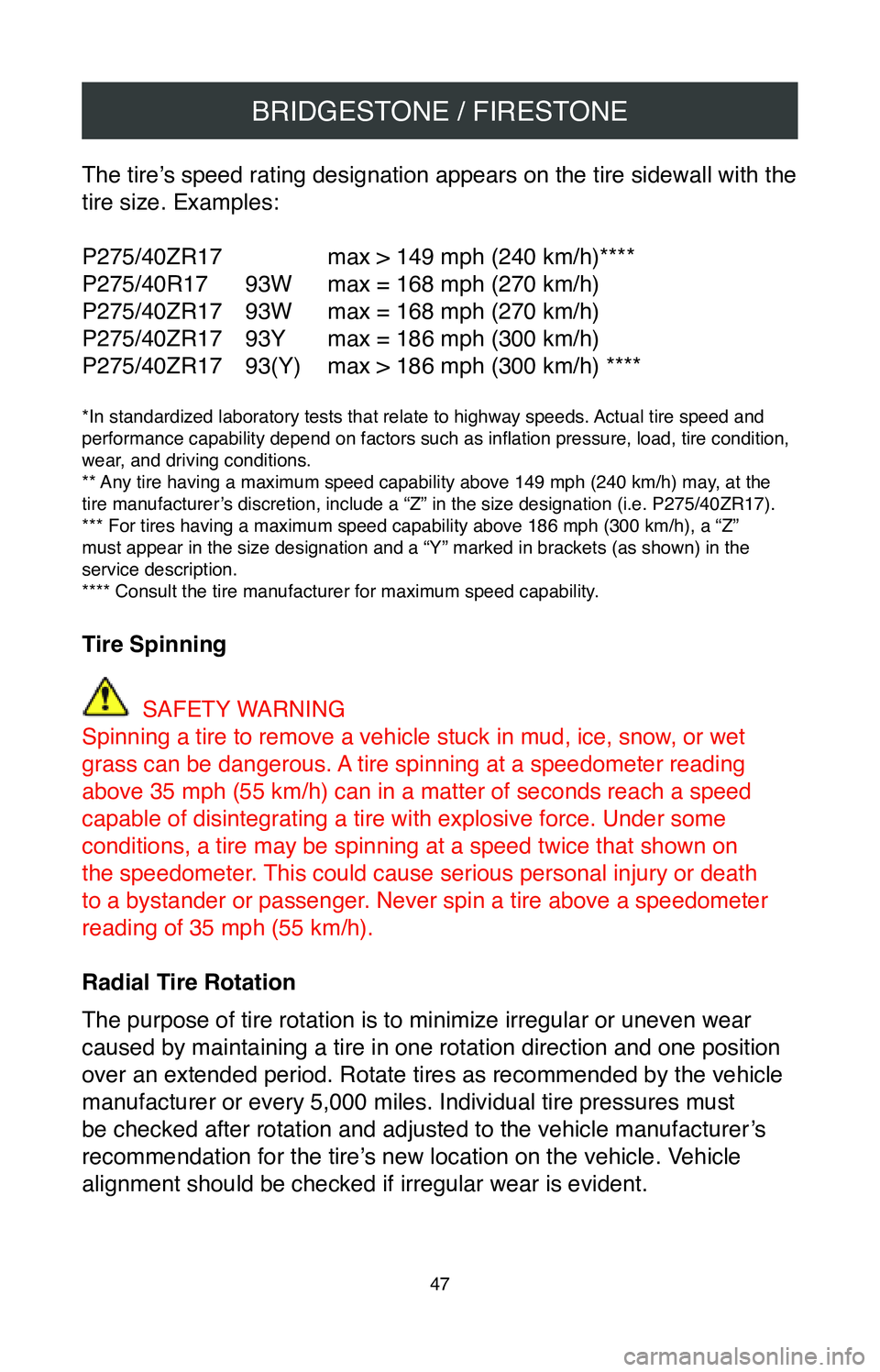2020 TOYOTA HIGHLANDER service
[x] Cancel search: servicePage 45 of 260

BRIDGESTONE / FIRESTONE
43
• Never put flammable substances in tire/wheel assemblies at
any time. Never put any flammable substance into a tire/wheel
assembly and attempt to ignite to seat the beads.
•
Always stand well away from the work area when tires are being
spin balanced either on or off the vehicle.
High Performance, Low Aspect Ratio Tires
Many new vehicles come equipped from the factory with high
performance and/or low aspect ratio tires. Generally, these tires
provide increased vehicle handling capability, but may also have
numerous engineering performance trade-offs associated with
their designs. •
Low aspect ratio tires, with reduced sidewall height, may be
more susceptible to damage from potholes, road hazards, and
other objects such as curbs. This is true for the wheels as well.
Therefore, as with all other tires, it is important to drive with care
and maintain proper inflation pressure and load conditions. See
“Tire Inflation Pressure” and “Tire Damage, Inspection and Service
Life” in this manual.
•
Some sports cars and other handling performance enhanced
vehicles, including sedans and light trucks/SUVs, may be originally
equipped with high performance tires that are more optimized
for warmer weather use. Colder, winter weather traction may be
reduced for these types of tires. Winter tires may be recommended
by the vehicle manufacturer for colder weather application. See
“Winter Tires,” the next section in this manual.
•
High performance tires may also wear more quickly, ride more
firmly, and produce more noise during operation.
Consult your vehicle owner’s manual and tire information placard, or
a qualified tire service professional, for more information and specifics
regarding these types of tires.
Page 46 of 260

BRIDGESTONE / FIRESTONE
44
Winter Tires
SAFETY WARNING
Winter driving presents special challenges for vehicle mobility. The use
of winter tires (including studs and chains)—while improving traction
performance in snow and ice—requires special care with regard to
acceleration, braking, cornering, and speed. It is important to drive wi\
th
care, not only on snow and ice, but on dry and wet roads as well.
In winter driving conditions, vehicle control and safe operation under
braking and cornering is especially dependent upon the rear tires. For
this reason, winter tires are best applied to all wheel positions. Some \
vehicles have specific recommendations regarding winter tire use;
consult your vehicle owner’s manual and tire information placard.
•
If winter tires are to be applied to the front axle of any vehicle,
they must also be applied to the rear axle for safe operation. This
applies to all passenger cars and light trucks, including front wheel
drive, 4x4, and all-wheel-drive vehicles.
•
If winter tires are to be applied to the rear axle of any vehicle, it is\
recommended that they also be installed on the front axle.
•
It is generally acceptable to apply a tire with a lower speed rating
than your original tires for use in winter weather conditions;
however, speed should be reduced accordingly. All winter tires
should be the same speed rating. See “Tire Speed Ratings” in
this manual.
•
Winter tires used in warmer, summer weather conditions may wear
more rapidly.
•
Studded winter tires follow the same recommendations as
above; consult a qualified tire service professional for information
regarding any seasonal restrictions.
Tire Mixing
SAFETY WARNING
Driving your vehicle with an improper mix of tires is dangerous. Your
vehicle’s handling characteristics can be seriously affected. You could
Page 47 of 260

BRIDGESTONE / FIRESTONE
45
have an accident resulting in serious personal injury or death. Consult
your vehicle owner’s manual and a qualified tire service professional
for proper tire replacement.
High Speed Driving
SAFETY WARNING
Driving at high speed is dangerous and can cause a vehicle accident,
including serious personal injury or death.
•
Regardless of the speed and handling capabilities of your car and
its tires, a loss of vehicle control can result from exceeding the
maximum speed allowed by law or warranted by traffic, weather,
vehicle, or road conditions.
•
High-speed driving should be left to trained professionals operating
under controlled conditions.
•
No tire, regardless of its design or speed rating, has unlimited
capacity for speed, and a sudden tire failure can occur if its limits
are exceeded. See “Tire Speed Ratings,” the next section in
this manual.
Refer to your vehicle owner’s manual for any tire pressure
recommendations for high speed driving.
Tire Speed Ratings
A tire bearing a letter “speed rating” designation indicates the
tire’s speed capability according to standardized laboratory tests.
This speed rating system is intended to permit comparison of the
speed capabilities of different tires. When replacing your tires,
consult your vehicle owner’s manual and tire information placard for
recommendations, if any, concerning the use of speed rated tires. •
To avoid reducing the speed capability of the vehicle, replace a
speed rated tire only with another tire having at least the same
speed rating. It is the “top speed” of the “slowest” tire on\
the
vehicle which limits the vehicle’s top speed without tire failure.
•
The tire’s speed rating is void if the tire is repaired, retreaded,
damaged, abused, or otherwise altered from its original condition.
Page 48 of 260

BRIDGESTONE / FIRESTONE
46
Thereafter, it should be treated as a non-speed rated tire.
•
Non-speed rated tires are usually for ordinary passenger car or
light truck service and not for high speed driving.
•
For winter tires used in cold weather conditions, it is generally
acceptable to apply a tire with a lower speed rating than your
original tires; however, speed should be reduced accordingly. All
winter tires should be the same speed rating. Some vehicles have
specific recommendations regarding winter tire use; consult your
vehicle owner’s manual and tire information placard. See “Winter
Tires” in this manual.
These speed ratings are based on standardized laboratory tests
under specific, controlled conditions. While these tests may relate to
performance on the road, real-world driving is rarely identical to any
test conditions. Your tire’s actual speed capability may be less than its
rated speed since it is affected by factors such as inflation pressure,
load, tire condition (including damage), wear, vehicle condition
(including alignment), driving conditions, and duration at which the
speed is sustained. Use the following chart to compare the speed
ratings of tires.
Speed Speed Category*
Symbol mph km/h
M81130
Q 99160
R 106170
S 112180
T 118190
U 124200
H 130210
V 149240
Z** >149 >240
W 168270
Y 186300
(Y)*** >186 >300
Page 49 of 260

BRIDGESTONE / FIRESTONE
47
The tire’s speed rating designation appears on the tire sidewall with the
tire size. Examples:
P275/40ZR17
max > 149 mph (240 km/h)****
P275/40R17
93W max = 168 mph (270 km/h)
P275/40ZR17
93W max = 168 mph (270 km/h)
P275/40ZR17
93Y max = 186 mph (300 km/h)
P275/40ZR17
93(Y) max > 186 mph (300 km/h) ****
*In standardized laboratory tests that relate to highway speeds. Actual tire speed and
performance capability depend on factors such as inflation pressure, load, tire condition,
wear, and driving conditions.
** Any tire having a maximum speed capability above 149 mph (240 km/h) may, at the
tire manufacturer’s discretion, include a “Z” in the size designation (i.e. P275/40ZR17).
*** For tires having a maximum speed capability above 186 mph (300 km/h), a “Z”
must appear in the size designation and a “Y” marked in brackets (as shown) in the
service description.
**** Consult the tire manufacturer for maximum speed capability.
Tire Spinning
SAFETY WARNING
Spinning a tire to remove a vehicle stuck in mud, ice, snow, or wet
grass can be dangerous. A tire spinning at a speedometer reading
above 35 mph (55 km/h) can in a matter of seconds reach a speed
capable of disintegrating a tire with explosive force. Under some
conditions, a tire may be spinning at a speed twice that shown on
the speedometer. This could cause serious personal injury or death
to a bystander or passenger. Never spin a tire above a speedometer
reading of 35 mph (55 km/h).
Radial Tire Rotation
The purpose of tire rotation is to minimize irregular or uneven wear
caused by maintaining a tire in one rotation direction and one position \
over an extended period. Rotate tires as recommended by the vehicle
manufacturer or every 5,000 miles. Individual tire pressures must
be checked after rotation and adjusted to the vehicle manufacturer ’s
recommendation for the tire’s new location on the vehicle. Vehicle
alignment should be checked if irregular wear is evident.
Page 50 of 260

BRIDGESTONE / FIRESTONE
48
For vehicles with a “temporary use” spare tire, follow the vehicle\
manufacturer’s recommended pattern for rotation, or, if not provided,
the following may be used:
If your spare is the same size, load rating, and type of tire as your ro\
ad
tires, it should be included in the tire rotation process. For vehicles \
with
a “full-size” spare, the following rotation pat- terns may be used:
FULL SIZE SPAREFULL SIZE SPARE
Note:
•
Never include a “temporary use” spare tire in the rotation.
•
Tires with directional tread patterns must be rotated so the
direction of revolution does not change; this may require
demounting/mounting the tires.
•
Special attention should be given if your vehicle is equipped with
a Tire Pressure Monitoring System (TPMS). Rotation of your tires
may affect the system; consult your vehicle owner’s manual or a
qualified tire service professional.
•
Some vehicles may have different size tires/wheels on front and
rear which would restrict rotation. Always check and follow the
vehicle manufacturer’s rotation recommendation.
Page 51 of 260

BRIDGESTONE / FIRESTONE
49
• To use a full-size spare in the rotation pattern on vehicles with
dual rear wheels, consult your vehicle owner’s manual for the
recommended procedures or consult the vehicle manufacturer.
Your Spare Tire
Consult your vehicle owner’s manual for proper application of your
spare tire. Your car may be equipped with a “temporary use” spare tire;
this spare may differ in size and construction from the other tires on
your vehicle.
SAFETY WARNING
Check inflation pressure before use. Failure to have proper inflation
pressure when using your spare tire can result in serious personal
injury or death. See “Tire Inflation Pressure” in this manual.
SAFETY WARNING
Mounting a “temporary use” tire on a wheel which is not specifically
designed for it, or placing another type tire on a wheel designated
for temporary use can be dangerous. Your vehicle’s handling
characteristics can be seriously affected. You could have an accident
resulting in serious personal injury or death. Consult your vehicle
owner’s manual for proper application of your “temporary use”
spare tire.
The spare tire in your vehicle is intended to be used as a spare when
needed. The spare tire carrier is not intended to be used for long
term storage, except for “temporary use” tires. If your spare is t\
he
same size, load rating, and type of tire as your road tires, it should b\
e
included in the tire rotation process; see “Radial Tire Rotation” in this
manual for more information.
The spare should be included in regular tire inspections and inflation
pressure checks. In addition, it should be replaced 10 years after
date of manufacture, regardless of condition or tread depth. For more
information, see the “Tire Damage, Inspection and Service Life” in
this manual.
Page 52 of 260

BRIDGESTONE / FIRESTONE
50
Tire Storage
Tires should be stored indoors in a cool, dry place where water
cannot collect inside them. Tires should be placed away from electric
generators/motors and sources of heat such as hot pipes. Storage
surfaces should be clean and free of grease, gasoline or other
substances which can deteriorate the rubber.
SAFETY WARNING
Improper storage can damage your tires in ways that may not be
visible and can lead to a failure resulting in serious personal injury
or death.
The spare tire in your vehicle is intended to be used as a spare when
needed. The spare tire carrier is not intended to be used for long term
storage, except for “temporary use” tires. For more information, s\
ee
“Your Spare Tire” and “Radial Tire Rotation” in this manual.
Tire Service Customer Satisfaction
Normal tire maintenance and Limited Warranty services are available
at locations across the U.S.A. and Canada. For more information,
visit us on the internet at www.bridgestonetire.com, or please call the
Technical Service Department:
U.S.A.: (1-800-356-4644) or Canada: (1-800-267-1318).
Additional information on the care and service of automobile and light
truck tires is available from the following organizations:
U.S. Tire Manufacturers Association
1400 K Street, N.W.
Washington, DC 20005-2403
www.ustires.org
Tires and Rubber Association of Canada
A19–260 Holiday Inn Drive
Cambridge, ON, N3C 4E8
www.rubberassociation.ca